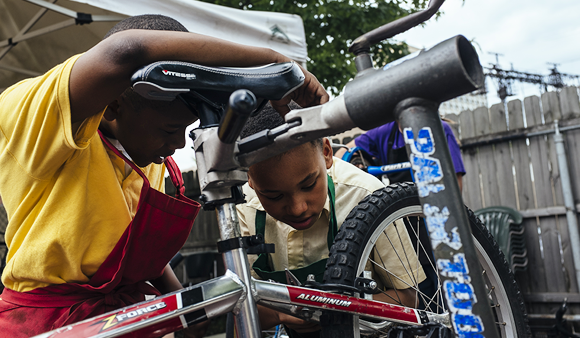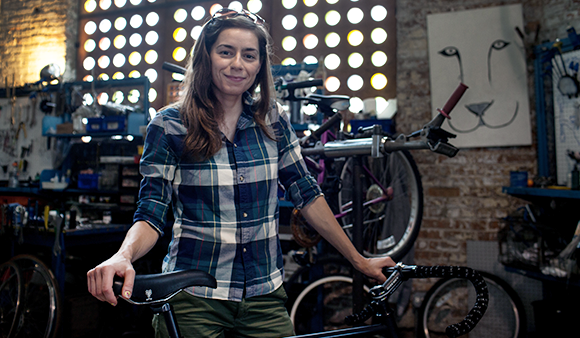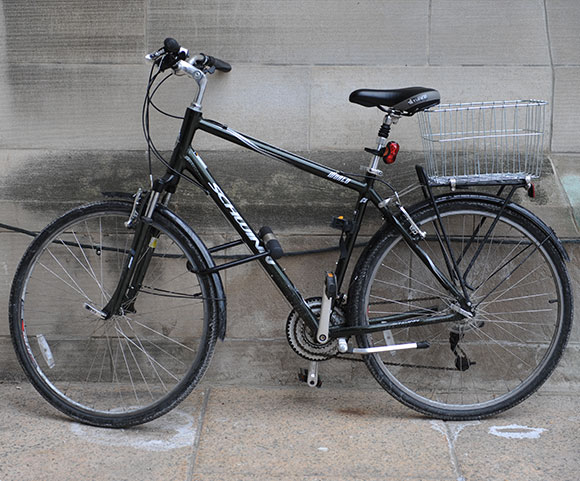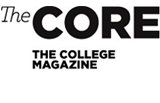
I want to ride my bicycle
When is a bicycle more than a ride? When it’s used to teach South Side history, mechanical skills, and entrepreneurship.
Benjamin Recchie, AB’03
It’s a gray and drizzling October Saturday morning when I go to 53rd Street Bicycle Center to pick up my rental cruiser. The bike is sturdy and conservative, perfect for an inexperienced rider like me to tag along on the annual bike tour of the South Side, led by noted campus bicyclist Dean John Boyer, AM’69, PhD’75, the Martin A. Ryerson Distinguished Service Professor in History.
Riding a bike is like, well, riding a bike: once you learn how, you never forget. Which is good, because I haven’t ridden in nine years. Yet I’m about to embark on a four-and-a-half-hour 17-mile ride on city streets.
When I arrive at the Reg, starting point for the tour, I discover it’s been postponed an hour until the rain passes. It’s almost 11:30 when we regroup. Dean Boyer leads the 20 or so riders—mostly undergrads by the look of it, along with two other faculty members—down 57th Street to the DuSable Museum of African American History, escorted by bike marshals from the organization Bronzeville Bikes.
At the museum Boyer and John Mark Hansen, the Charles L. Hutchinson Distinguished Service Professor in the Department of Political Science, tell us about the racial battles over the use of Washington Park in the 1910s and ’20s. The museum, an elegant former park administration building, is now named for Jean Baptiste Point DuSable, Chicago’s first non–Native American (and first black) settler.
As we make our way north along Drexel Boulevard past Victorian-era mansions, a bike marshal pulls up alongside me. “How does that bike ride?” she wants to know.
“Uh,” I respond. “I can’t say. I have no basis of comparison.”
I should note that I did not crash once during this conversation.
The real reason for the ride is not simply to visit landmarks but to understand each stop as an example of sociological forces at work. At the quiet Stephen A. Douglas Tomb on 35th Street, we learn how that plot of land went from being Douglas’s country estate, to a Civil War POW camp, to a middle-class Irish and Jewish neighborhood, to the heart of the Black Metropolis, to a “blighted” slum, and finally to a dramatically rebuilt urban renewal project—all within a century.
A White Castle parking lot in Bronzeville is the springboard for a discussion about the Great Migration of southern African Americans to the cities of the North. At our northernmost stop, the Jane Addams Hull-House Museum, Terry Nichols Clark, professor of sociology, tells how Addams’s fight for the poor ventured into machine politics, as the mostly Protestant reformers went up against the mostly Catholic political machine.

Program coordinator Lindsay Knight, AB'06, AM'09, PhD'15. (Photography by Tom Tian, AB'10, and Anastasia Page)
I keep up with the rest of the group just fine. But low-speed maneuvering proves a problem. Traveling down Halsted Street south of Bridgeport, the group has to snake around a stopped CTA bus. Don’t hit the bus, I tell myself as I slow to a snail’s pace. Don’t hit the bus. Don’t hit the bus. Don’t hit the bus. Naturally, I hit the bus, albeit slowly enough that my outstretched hand easily absorbs the blow. My bike starts rattling unnervingly soon after that.
Our final stop is the stately Kenwood home of President Barack Obama—or as close as we can get, which is about a block away. (The president happens to be in town this weekend.) It’s a perfect place to sum up everything we’ve been told about race and politics; Obama’s presidency, explains Hansen, is the culmination of the union of Chicago’s ethnic politics with a liberal reform movement, a coalition pioneered by former mayor and Hyde Parker Harold Washington.
Our guides bid us adieu. Now an old pro at bicycling on Chicago streets, I feel only a little mortal terror while traversing Hyde Park to return my rattling rent-a-bike.
The kids
Bicycling has officially become A Thing. When I was growing up, it was transportation for children and health nuts only—even after I learned how to ride in second grade, I rarely cycled again. (How rarely? My own mother was unaware until last year that I had ever learned to ride at all.) My fondest desire from the age of five through 15 was to learn to drive a car.
People are much less skeptical of two-wheeled transportation today. One sign—if you can find it—is behind the University steam plant on 61st Street. Inside a rough-faced industrial building called the Experimental Station (which somehow seems to have no front door, only back doors on all sides), is a most unusual retail establishment, Blackstone Bicycle Works.
“It’s a youth program in the shape of a community bike shop,” explains Lindsay Knight, AB’06, AM’09, PhD’15 (political science), who serves as Blackstone Bicycle Works’ youth program and new initiatives coordinator. Which isn’t to say it’s not a bike shop—it very much is, with a two-story lofted space full of bicycles and equipment and several bikes under repair.
You can buy a new chain or a tire here, but the real mission is not profit but kids. Blackstone has 580 youths, aged eight to 19, registered for programs. About 300 of them attend regularly—on average 30 a day. There’s no cost to join, just a willingness to work and learn.
A sheet tacked to a wall explains how the kids work their way up. Everyone, regardless of age, starts with a gray apron, which means “you know what a bicycle is, presumably, but that’s about it,” Knight says. As the kids work on bikes, they acquire new skills—fixing a flat, cleaning a chain, replacing a derailleur. When they acquire five new skills at an apprentice level, as determined by a shop mentor, they move up to a green apron. Twenty-five skills earns them a red apron, and then up to purple and ultimately black for kids who can not only perform at a master level but teach skills to less experienced peers.
As well as skills, the children rack up hours. Twenty hours of working on bikes earns a child a bike to work on; after another five hours fixing it up, it’s theirs to keep. They can keep earning hours to buy accessories or market dollars redeemable at the Saturday farmer’s market next door. Ultimately the kids with black aprons can use their hours to buy bikes, fix them up, sell them, and keep the profits, says Knight: “A 15-year-old who can sell a $250 bike on the weekend and keep the profits is kind of awesome, considering they might not have other means of legitimate employment.” A lot of the kids use the money to pay for equipment they need to play on sports teams, she says, or for school supplies.

Students learn how to fix a flat and what tools are needed for what jobs. (Photography by Tom Tian, AB'10, and Anastasia Page)
On school days, the kids have to finish their homework before they can work on a bike. (At least if they’re under 12; older kids are on “the honor system,” Knight says.) Around 4 p.m. students start trickling in, mostly from Andrew Carnegie Elementary School next door. As the students finish their work, they drift away to the workshops downstairs. Knight talks to two boys about bicycle racing; she coaches a team of neighborhood children. One boy in a green apron expresses interest, but she tells him, “You have to be a purple or black apron to race.”
Down on the shop floor, a couple of bikes are up on stands for brake repairs. An adult mentor shows a girl with wire cutters how to fix a brake cable. “Now get the pliers,” he says softly. “The reason we do this is so the cables won’t splay out.” At another stand, a red-aproned girl and a gray-aproned one are fitting a new chain. These kids know much more about bicycles than I do. “We have a lot of 10-year-olds who are great mechanics,” says Chris Willard, the shop’s operations manager.
He puts me under the tutelage of 13-year-old Frederick Wallace. (Wanting the whole Blackstone Bikes experience, I don a novice’s gray apron.) Frederick shows me the first, most basic task apprentices learn: fixing a flat tire. An appropriate bike is selected and placed on a rack; Frederick (sporting a red apron) tries to wrench free the nuts holding the front wheel on. The threads on one nut are rusted; neither of us can dislodge it, and a knowledgeable adult is called to knock it loose.
Now the wheel is off, and Frederick hands me two plastic tools. “These are tire levers,” he says. “You stick them in like … that.” It’s my job to pry the tire loose from the wheel. After a few minutes (and much encouragement from Frederick), I do.
There’s an inner tube inside; we replace it with a fresh one. Two pumps of air give it just enough rigidity that we can work it back inside the tire. Frederick uses pliers to pull the valve stem of the inner tube through a hole in the wheel; then we work the whole tire back on. He replaces a tiny valve core that I never knew existed (“so when you’re riding the bike, the tire’s inner tube doesn’t deflate,” he explains), then has me pump it full. We replace the tire and use a toothbrush to apply grease to the axle bolt. Finally we replace the nuts we took off at the beginning.
“Boom! Everything’s finished,” Frederick says. Elapsed time: 20 minutes. I almost feel confident enough to do it again.
The advocate
John Greenfield, AB’93, has been a bicycling advocate for most of his adult life—starting when this was a rather eccentric thing to do. After earning an English degree, he worked as a bike messenger and then joined the Chicago Bicycling Federation (now the Active Transportation Alliance) in a position embedded within the Chicago Department of Transportation. Greenfield managed the City of Chicago’s bicycle parking program, locating outdoor racks and encouraging building owners to include bike rooms. In 2011 he cofounded the sustainable transportation website Grid Chicago, now Streetsblog Chicago, which advocates for pedestrian and bicycling issues.
Chicago’s modern history of bicycling goes back further than you might expect—to 1963, when Mayor Richard J. Daley named the lakefront trail a bicycle path. In the 1970s the elder Daley also oversaw the creation of the first bike lanes on city streets. In 1991 his son, Richard M. Daley, created the Mayor’s Bicycle Advisory Council and eventually built more than 100 miles of bike lanes and installed 10,000 racks, as well as outfitting CTA buses to carry bikes.
It’s not just my imagination that I’ve seen more bicyclists on the roads in the past few years, Greenfield says. The expansion of bike lanes and other cycling infrastructure in Chicago—from 142 miles in 2011, when Rahm Emanuel replaced Daley as mayor, to 228 today—has started a virtuous cycle (sorry) that attracts more riders, which in turn creates a greater demand for infrastructure. And safety is improving, even as the number of bicyclists increases. “The more bikes you have, the more people you have riding bikes, the more normal it is, the more drivers learn to look out for people on bikes,” he says.

Students wear different color aprons according to their skill level. (Photography by Tom Tian, AB'10, and Anastasia Page)
Greenfield notes that the number of bicycle trips in Chicago has doubled in the past decade, reflecting national trends. “Drivers are not as weirded out by having to share the road with bikes as they used to be. People are understanding things like ‘Look behind you when opening your car door so you don’t strike the cyclist,’ and ‘Don’t turn right at an intersection without looking for bikes.’”
Chicago’s no cyclist’s paradise—the weather alone ensures that—but how close could it come? Greenfield points to famously bike-friendly Portland, Oregon, which has a 6 percent bike mode share, meaning 6 percent of all trips are made on a bicycle; Chicago’s bike mode share, by comparison, is 1.6 percent. “It’s not really a matter of ‘Should bicyclists be on the road?’” says Greenfield, “but ‘What can be done to accommodate bicyclists?’”
Chicago’s bike mode share could rise as high as 4 percent, he surmises, roughly equal to San Francisco’s. “I think there’s going to be a big difference a decade from now,” Greenfield says, citing Emanuel’s increase in bike lanes as well as the well-received 2013 rollout of Divvy, a bicycle sharing system with 300 stations and 3,000 bikes across the city. The city has also turned an abandoned elevated railroad line on the North Side into the Bloomingdale Trail and Park, also known as the 606, a 2.7-mile bike-friendly linear park.
Finally I ask Greenfield the question that every driver asks himself when he swears at a cyclist riding the wrong way or blowing through a stop sign: does he think cyclists and drivers can learn to live in peace?
“I do,” he says. As more drivers ride bicycles occasionally, they’ll become more understanding of cyclists’ needs (and, one presumes, cyclists of drivers’ needs). The way of the future is “dedicated spaces for drivers and buses and bikes and pedestrians,” like the under-construction Loop Link downtown, which will have dedicated lanes for all forms of traffic. A happy future where everyone on the street knows his place, literally—a patch of pavement for all.
The dean
Dean Boyer didn’t set out to become a symbol of cycling. “I wasn’t trying to advocate for anything,” he insists. “It was just I’m a fairly impatient person, and I prefer to get where I’m going fast rather than slow.” In the late ’90s, freed from the burden of driving his children around, he started commuting from his Hyde Park home to campus via bicycle. It was a few more years before “people started noticing,” he says. Today Boyer’s public image on campus is intertwined with his bicycle.

Boyer’s bicycle. (Photography by Dan Dry)
Although bicycling is having a moment culturally, Boyer doesn’t attribute it to any one reason. There’s America’s increased health consciousness, he says, but there’s also the fact that cities’ (and particularly Chicago’s) investment in infrastructure makes biking a practical way to avoid traffic. “I’d like to think it’s kind of the American culture returning to a more sensible, more ecologically friendly place,” he muses. “Whether or not that’s actually the case, whether it stays that way, we’ll have to wait and see.”
The University’s Facilities Services is in the early stages of preparing a multimodal transportation plan that could make more room for cyclists. Boyer’s not involved, though he notes he has pushed for more bike racks as the number of bicyclists on campus has boomed. He encourages undergraduates to get a bike and ride it, not just to and from class but around the city.
The South Side history bike tour is part of that push. “What we try to communicate, showing by doing, is that this is a manageable city—you can even tour it,” Boyer says. “The whole point of the bike tour is to say that if you can ride from your apartment down to campus, you can also ride from your apartment down to the Newberry Library or Lincoln Park Zoo.” Experiencing the city on foot or bicycle is a far more immersive experience than seeing it through the window of a motor vehicle. “We want our students to go out into the city,” says Boyer, “to be of the city, not just Hyde Park.”
Pedestrian and state-licensed automobile driver Benjamin Recchie, AB'03, is the communications manager for the University of Chicago Research Computing Center.
